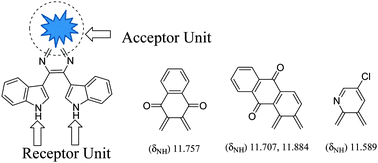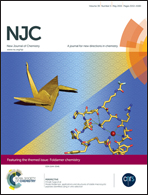Design, synthesis and characterization of indole based anion sensing receptors†
Abstract
The design and synthesis of six new receptors (R1–R6) and their anion sensing properties through multiple channels are reported. These receptors are constructed in such a way that they possess indole groups as the binding sites and different acceptors units of varying electron acceptor strengths. Receptors R1, R3 and R5 could recognize fluoride ions visually and spectroscopically with high selectivity over other anions in DMF, which was demonstrated by a visual detection experiment and UV-Vis, fluorescence and 1H NMR spectral studies. The remaining three receptors (R2, R4 and R6) exhibited colour changes with both fluoride and cyanide ions. The binding constants for fluoride binding by these receptors were determined to be in the order of 104 to 106 M−1 and found to depend on the electron accepting property of the acceptor unit in the intra molecular charge transfer (ICT) transition existing with the indole donor units. 1H NMR titration experiments not only provide evidence for the existence of H-bonding interactions between the indolic N–H groups of these receptors and F−, but also offer key insight into the strengths of the receptor–anion complexes of stoichiometry 1 : 2. The higher fluoride binding ability of the receptor containing the naphthoquinone signalling unit has been interpreted in terms of the greater electron deficiency of the acceptor unit (quinone) and enhanced H-bond donating character of the indole N–H group. The results of the electrochemical and DFT computation studies corroborate well with the spectroscopic studies.


 Please wait while we load your content...
Please wait while we load your content...